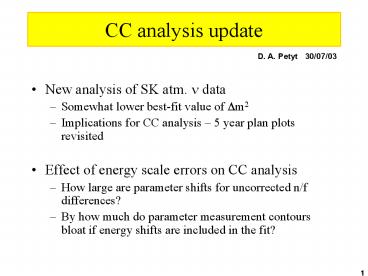CC analysis update PowerPoint PPT Presentation
1 / 13
Title: CC analysis update
1
CC analysis update
D. A. Petyt 30/07/03
- New analysis of SK atm. n data
- Somewhat lower best-fit value of Dm2
- Implications for CC analysis 5 year plan plots
revisited - Effect of energy scale errors on CC analysis
- How large are parameter shifts for uncorrected
n/f differences? - By how much do parameter measurement contours
bloat if energy shifts are included in the fit?
2
Allowed region of the oscillation parameters
from atmospheric n data
(complete SK-I dataset)
Assuming nm nt oscillation
FC PC up-going m combined
Best fit
c2min 170.8/170 d.o.f.
at (sin22q, Dm2)
1489 days
(1.0,2.0 x 10-3 eV2)
Preliminary!
90 confidence level
allowed region
68 C.L.
sin22q gt 0.9
90 C.L.
99 C.L.
1.3x10-3 lt Dm2 lt3.0x10-3
(eV2)
Previous limits 1.6e-3,3.8e-3
Assuming null oscillation
c2 445.2/172 d.o.f.
Slides from Hayatos talk, EPS 2003
3
Comparison between old and new results from
atmospheric n data
- Neutrino flux
- (Honda 1995 Honda 2001)
3D flux calculation
- Neutrino interaction models
- (several improvements,
- agree with K2K near data)
- Improved detector simulation
- Improved event reconstruction tools
Each change slightly shifted the allowed
region to lower Dm2
Previous best fit outside physical region
Slides from Hayatos talk, EPS 2003
4
MINOS CC sensitivity updated
5
Seeing a dip/rise in spectrum ratio
New SK region
- Hard to see a significant rise in spectrum
ratio for values of Dm2 below 0.0025-0.003 eV2
(Edip 1.5-1.8 GeV). - Almost all of new SK region is below this Dm2
range motivation for plans to improve low E
flux?
6
Energy scale uncertainties
- What are the effects of Near/far energy scale
differences on the CC energy analysis? - This was brought up at the collaboration meeting
this systematic error is not currently included
in 5 year plan plot calculations - Chris has looked at this in connection with his
QEL analysis. I last looked at it gt5 years ago - Current energy scale calibration requirements
- 2 relative near to far, 5 absolute
- Not entirely certain where these numbers came
from. False signal searches using the Z-test? - The following is a quick study to see how energy
scale uncertainties affect parameter measurement
in the 5-year plot era analysis - Shift far energy scale relative to near
- Assume a constant factor Efar(1?)Enear
- Look at effects of shifts in hadron and muon
energy scales separately - Perform fits where n/f energy scale is allowed to
float. - Second-order effects (changes in selection
efficiencies etc.) not included
7
CC energy fits, /- 5 overall shifts
Shifts in both Dm2 and sin22q. 5 best fit is
outside physical region
8
CC energy fits, /- 2 overall shifts
9
/- 5 shifts in hadron energy scale only
10
/- 5 shifts in muon energy scale only
Predominance of low-y/QEL events in CC sample
effect of muon energy scale shift is therefore
greater than an equivalent shift in the hadron
energy scale
11
Incorporating energy scale uncertainties into the
fit
- For each pair of Dm2,sin22q values, there is an
additional loop over the energy scale parameter,
e (100 points, 0.9ltelt1.1). - I calculate chisq for this (Dm2,sin22q,e) and add
a penalty factor e2/sE2, where sE is the expected
uncertainty in the near/far energy scale. c2 is
then minimised with respect to the parameter e
12
Shape-only fits
13
Results and conclusions
Size of Dm2 measurement errors
- Including simple energy scale uncertainties of
the form Efar(1e)Enear into the fit increases
the size of the contours by a small amount - Fit is tightly constrained by shape and
normalisation at the value of Dm2 used here - May be a different story at low Dm2, where dip is
not resolved. - Should also look at this for high proton
intensities (only looked at low 7.4e20 p.o.t.
proton intensity here). When do systematic
uncertainties dominate over statistical
uncertainties? (This is one of the main themes of
the new PAC questions.)

